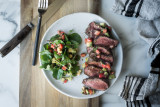
Course
Small Bites
Chiltepin, similar to the chile pequin, is the smallest of all peppers and indigenous to the southwestern United States and northern Mexico. Considered to be the oldest and only native chile in North America, this pepper is woven into the fabric of our history.
Roughly the size of a peppercorn, the Chiltepin ranges from 50,000 to 100,000 units on the Scoville scale, making it just as spicy as a Thai bird’s eye chile! These tiny peppers are propagated by a variety of wild birds, earning its nickname as the bird chile.
The small green bush in which they grow upon can pop up unexpectedly in the most unassuming places. The typical harvest season is during the late summer and early fall. However, with the unseasonably warm and wet weather, these peppers didn’t ripen from green (when they are hottest) to red until early November in my neck of the woods.
I forage these peppers at my family’s ranch where they grow wild, and was able to pluck a large can for various preparations. The bulk of my chiles were pickled in vinegar to sprinkle on sautéed greens, but my favorite thing to make is fresh salsa. Because they are so hot, it only takes a handful to make a big batch. The recipe below makes roughly two cups worth of salsa, but let me forewarn you the spice level isn’t for the faint of heart!
Ingredients
- 8 roma tomatoes, quartered
- 1 small yellow onion, cut into quarters
- 6 cloves of garlic, unpeeled
- Salt and pepper
- 1 tbsp. avocado, canola or grapeseed oil
- 2 tbsp. fresh Chiltepins or Chile Pequins
- 1/4 tsp. cumin
- 1 tsp. dried oregano
- 1/4 cup cilantro leaves
- 1/2 lime, juiced
Special equipment
Preparation
- Preheat the oven to 400 degrees. On a large sheet pan, spread the garlic, quartered tomatoes and onions across. Drizzle with oil and sprinkle with salt and pepper. Roast in the oven for roughly 20 minutes, or until the onion starts to soften and char. Add the Chiltepins to the sheet pan of tomatoes and roast for another 10 minutes.
- Remove sheet pan from oven. Take the garlic cloves out when cool to the touch and peel. Pour the roasted peppers, tomatoes (along with the juices), and onions into a food processor. Add the roasted garlic cloves. Season with cumin, oregano, cilantro and lime juice. Pulse until the ingredients are well blended and still chunky, or to a smoother consistency as desired. Season to taste with additional salt, pepper or lime juice.
Sign In or Create a Free Account
Reviews
Chiltepin, similar to the chile pequin, is the smallest of all peppers and indigenous to the southwestern United States and northern Mexico. Considered to be the oldest and only native chile in North America, this pepper is woven into the fabric of our history.
Roughly the size of a peppercorn, the Chiltepin ranges from 50,000 to 100,000 units on the Scoville scale, making it just as spicy as a Thai bird’s eye chile! These tiny peppers are propagated by a variety of wild birds, earning its nickname as the bird chile.
The small green bush in which they grow upon can pop up unexpectedly in the most unassuming places. The typical harvest season is during the late summer and early fall. However, with the unseasonably warm and wet weather, these peppers didn’t ripen from green (when they are hottest) to red until early November in my neck of the woods.
I forage these peppers at my family’s ranch where they grow wild, and was able to pluck a large can for various preparations. The bulk of my chiles were pickled in vinegar to sprinkle on sautéed greens, but my favorite thing to make is fresh salsa. Because they are so hot, it only takes a handful to make a big batch. The recipe below makes roughly two cups worth of salsa, but let me forewarn you the spice level isn’t for the faint of heart!
Ingredients
- 8 roma tomatoes, quartered
- 1 small yellow onion, cut into quarters
- 6 cloves of garlic, unpeeled
- Salt and pepper
- 1 tbsp. avocado, canola or grapeseed oil
- 2 tbsp. fresh Chiltepins or Chile Pequins
- 1/4 tsp. cumin
- 1 tsp. dried oregano
- 1/4 cup cilantro leaves
- 1/2 lime, juiced
Special equipment
Preparation
- Preheat the oven to 400 degrees. On a large sheet pan, spread the garlic, quartered tomatoes and onions across. Drizzle with oil and sprinkle with salt and pepper. Roast in the oven for roughly 20 minutes, or until the onion starts to soften and char. Add the Chiltepins to the sheet pan of tomatoes and roast for another 10 minutes.
- Remove sheet pan from oven. Take the garlic cloves out when cool to the touch and peel. Pour the roasted peppers, tomatoes (along with the juices), and onions into a food processor. Add the roasted garlic cloves. Season with cumin, oregano, cilantro and lime juice. Pulse until the ingredients are well blended and still chunky, or to a smoother consistency as desired. Season to taste with additional salt, pepper or lime juice.






